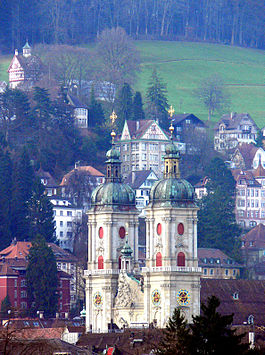St Gallen
| Sankt Gallen | ||
|---|---|---|

The Abbey Cathedral of St Gall and the old city
|
||
|
||
| Coordinates: 47°25′N 9°22′E / 47.417°N 9.367°ECoordinates: 47°25′N 9°22′E / 47.417°N 9.367°E | ||
| Country | Switzerland | |
| Canton | St. Gallen | |
| District | St. Gallen | |
| Government | ||
| • Executive |
Stadtrat with 5 members |
|
| • Mayor |
Stadtpräsident (list) Thomas Scheitlin FDP/PRD (as of February 2014) |
|
| • Parliament |
Stadtparlament with 63 members |
|
| Area | ||
| • Total | 39.39 km2 (15.21 sq mi) | |
| Elevation | 675 m (2,215 ft) | |
| Highest elevation (Birt) | 1,074 m (3,524 ft) | |
| Lowest elevation (Goldachtobel) | 496 m (1,627 ft) | |
| Population (Dec 2015) | ||
| • Total | 75,538 | |
| • Density | 1,900/km2 (5,000/sq mi) | |
| Postal code | 9000 | |
| SFOS number | 3203 | |
| Localities | Wolfganghof, Winkeln, Bruggen, Lachen, Rosenberg, Riethüsli, St. Georgen, Innenstadt, St. Jakob, Linsenbühl-Dreilinden, Rotmonten, Langgass-Heiligkreuz, St. Fiden, Notkersegg, Neudorf, Achslen, Guggeien | |
| Surrounded by | Eggersriet, Gaiserwald, Gossau, Herisau (AR), Mörschwil, Speicher (AR), Stein (AR), Teufen (AR), Untereggen, Wittenbach | |
| Twin towns | Liberec (Czech Republic) | |
| Website |
www SFSO statistics |
|
| Imperial City of St. Gallen | ||||||||||
| Reichsstadt Sankt Gallen | ||||||||||
|
State of the Holy Roman Empire (to 1499 / 1648) Old Swiss Confederacy associate and protectorate (1454–1798) |
||||||||||
|
||||||||||
| Capital | St. Gallen | |||||||||
| Languages | High Alemannic | |||||||||
| Government | Republic | |||||||||
| Historical era | Renaissance, Baroque | |||||||||
| • | City founded | ca. 974 | ||||||||
| • | Gained Reichsfreiheit | 1401 | ||||||||
| • | Abbey became Old Swiss Confederacy protectorate | 17 August 1451 | ||||||||
| • | Associate & protectorat of Old Swiss Confederacy |
13 June 1454 |
||||||||
| • | Swabian War: de facto independent from Holy Roman Empire | 1499 | ||||||||
| • | Peace of Westphalia: de jure independence | 1648 | ||||||||
| • | Annexed to Helvetic Republic canton of Säntis | 1798 | ||||||||
| • | Helvetic Republic collapsed; city & abbey became part of newly founded canton of St. Gallen |
1803 |
||||||||
|
||||||||||
| Largest groups of foreign residents 2011 | ||
| Nationality | Numbers | % of total (% of foreigners) |
|---|---|---|
|
|
5,118 | 7.0 (24.7) |
|
(incl. Montenegro and Kosovo) |
3,231 | 4.4 (15.6) |
|
|
2,587 | 3.5 (12.5) |
|
|
1,093 | 1.5 (5.3) |
|
|
952 | 1.3 (4.6) |
|
|
870 | 1.2 (4.2) |
|
|
787 | 1.1 (3.8) |
|
|
780 | 1.0 (3.8) |
|
|
585 | 0.8 (2.8) |
|
|
530 | 0.7 (2.6) |
St. Gallen or traditionally St Gall, in German sometimes Sankt Gallen (![]() Sankt Gallen ; English: St Gall; French: Saint-Gall; Italian: San Gallo; Romansh: Son Gagl) is the capital of the canton of St. Gallen in Switzerland. It evolved from the hermitage of Saint Gall, founded in the 7th century. Today, it is a large urban agglomeration (with around 160,000 inhabitants) and represents the center of eastern Switzerland. Its economy consists mainly of the service sector.
Sankt Gallen ; English: St Gall; French: Saint-Gall; Italian: San Gallo; Romansh: Son Gagl) is the capital of the canton of St. Gallen in Switzerland. It evolved from the hermitage of Saint Gall, founded in the 7th century. Today, it is a large urban agglomeration (with around 160,000 inhabitants) and represents the center of eastern Switzerland. Its economy consists mainly of the service sector.
The main tourist attraction is the Abbey of Saint Gall, a UNESCO World Heritage Site. The Abbey's renowned library contains books from the 9th century.
The official language of St. Gallen is (the Swiss variety of Standard) German, but the main spoken language is the local variant of the Alemannic Swiss German dialect.
The city has good transport links to the rest of the country and to neighbouring Germany and Austria. It also functions as the gate to the Appenzell Alps.
...
Wikipedia



